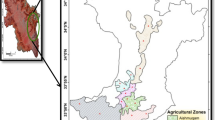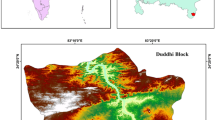Abstract
Teesta river basin is one of the hazard-prone areas in Bangladesh. Flood, riverbank erosion and hailstorm are the most devastating natural hazards to agriculture in this area. Therefore, adaptation measures are obligatory to sustain the livelihood and food security of the households. This study has investigated the indigenous and institutional adaptation measures of the farming households using survey data collected from three districts of Bangladesh. The results reveal that more than half of the respondents have changed the crops’ seeding or planting time, adopting resilient crop varieties to avoid the climatic hazards, whereas about 45% of respondents have adopted crop rotation to sustain soil fertility. They also adopt non-agricultural adaptation strategies such as a change in profession, taking credit from different sources and using agricultural land for non-agricultural purposes. Poor farmers receive relatively little support from the government to enhance their adaptation strategies. Institutional support such as technical and financial support is needed to promote farmers’ adaptation process.
Access this chapter
Tax calculation will be finalised at checkout
Purchases are for personal use only
Similar content being viewed by others
References
Alam K (2015) Farmers’ adaptation to water scarcity in drought-prone environments: a case study of Rajshahi District, Bangladesh. Agric Water Manag 148:196–206
Alam GMM (2016) An assessment of the livelihood vulnerability of the riverbank erosion hazard and its impact on food security for rural households in Bangladesh. Ph.D. thesis, University of Southern Queensland, Queensland, Australia
Alam GMM, Alam K, Shahbaz M (2017) Climate change perceptions and local adaptation strategies of hazard-prone rural households in Bangladesh. Clim Risk Manag 17:52–63
Alam GMM, Alam K, Mushtaq S, Khatun MN, Filho WL (2018) Strategies and barriers to adaptation of hazard-prone rural households in Bangladesh. In: Filho WL, Nalau J (eds) Limits to climate change adaptation. Springer International Publishing AG
Ahmed Z, Guha GS, Shew AM, Alam GMM (2021) Climate change risk perceptions and agricultural adaptation strategies in vulnerable riverine char islands of Bangladesh. Land Use Policy 103(4):105295
Aryal JP, Sapkota TB, Khurana R, Khatri-Chhetri A, Rahut DB, Jat ML (2019) Climate change and agriculture in south Asia: adaptation options in smallholder production systems. Environ Dev Sustain
Azad MAK, Hossain MZ, Karmakar S (2013) Impact of climatic elements on winter crop productivity in Rangpur area of Bangladesh. J Environ Sci Nat Resour 6(2):149–155
Baky AA, Zaman AM, Khan AU (2012). Managing flood flows for crop production producing risk management with hydraulic and GIS modeling: case study of agricultural areas in Shariatpur. APCBEE Procedia, Part 8–324
Bhatta GD, Ojha HR, Aggarwal PK, Sulaiman VR, Sultana P, Thapa D, Mittal N, Dahal K, Thomson P, Ghimire L (2017) Agricultural innovation and adaptation to climate change: empirical evidence from diverse agro-ecologies in south Asia. Environ Dev Sustain 19:497–525
Bradshaw B, Dolan H, Smit B (2004) Farm-level adaptation to climatic variability and change: crop diversification in the Canadian Prairies. Clim Change 67:119–141
Das J, Mandal T, Rahman AS, Saha P (2021) Spatio-temporal characterization of rainfall in Bangladesh: an innovative trend and discrete wavelet transformation approaches. Theoret Appl Climatol 143(3):1557–1579. https://doi.org/10.1007/s00704-020-03508-6
Dastagir MR (2015) Modeling recent climate change induced extreme events in Bangladesh: a review. Weather Clim Extremes 7:49–60
Fitton N, Alexander P, Arnell N, Bajzelj B, Calvin K, Doelman J, Gerber JS, Havlik P, Hasegawa T, Herrero M, Krisztin T, Meijl HV, Powell T, Sands R, Stehfest E, West PC, Smith P (2019) The vulnerabilities of agricultural land and food production to future water scarcity. Glob Environ Chang 58:101944
Gosling SN, Arnell NW (2016) A global assessment of the impact of climate change on water scarcity. Clim Change 134:371–385
Habiba U, Shaw R, Takeuchi Y (2011) Socio-economic impact of droughts in Bangladesh. Commun Environ Disaster Risk Manage 8:25–48
Islam MS, Sultana S, Saifunnahar, Miah MA (2014) Adaptation of char livelihood in flood and river erosion areas through indigenous practices: a study on Bhuapur riverine area in Tangail. J Environ Sci Nat Resour 7(1):13–19
Jamshidi O, Asadia A, Kalantaria K, Azadib H, Scheffran J (2019) Vulnerability to climate change of smallholder farmers in the Hamadan province, Iran. Clim Risk Manage 23:146–159
Kabir MI, Rahman MB, Smith W, Lusha MAF, Milton AH (2016) Climate change and health in Bangladesh: a baseline cross-sectional survey. Glob Health Action 9(1)
Kamruzzaman M, Rahman ATMS, Kabir ME, Jahan CS, Mazumder QH, Rahman MS (2016a) Spatio-temporal analysis of climatic variables in the western part of Bangladesh. Environ Dev Sustain 18(6)
Kamruzzaman M, Kabir ME, Rahman ATMS, Mazumder QH, Rahman MS, Jahan CS (2016b) Modeling of agricultural drought risk pattern using Markov Chain and GIS in the western part of Bangladesh. Environ Dev Sustain 18(6)
Kamruzzaman M, Mandal T, Rahman ATM, Khalek A, Alam GMM (2021) Climate modeling, drought risk assessment and adaptation strategies in the western part of Bangladesh. In: Alam et al (eds) Climate vulnerability and resilience in the global south, pp 103–129
Kamruzzaman M, Rahman ATMS, Basak A, Alam J, Das J (2022). Assessment of climate change impacts and adaptation strategies through the prism of farmers’ perception: a case study. Int J Environ Sci Technol:1–20.https://doi.org/10.1007/s13762-022-04254-0
Karim M, Thiel A (2017) Role of community based local institution for climate change adaptation in the Teesta riverine area of Bangladesh. Clim Risk Manag 17:92–103
Kothari CR (2004) Research methodology: methods and techniques. New Age International (p) Limited, New Delhi
Manandhar S, Vogt DS, Perret SR, Kazama F (2011) Adapting cropping systems to climate change in Nepal: a cross-regional study of farmers’ perception and practices. Reg Environ Change 11:335–348
Maponya P, Mpandeli S (2012) Climate change and agricultural production in south Africa: Impacts and adaptation options. J Agric Sci 4(10):48–60
Meldrum G, Mijatovic D, Rojas W, Flores J, Pinto M, Mamani G, Condori E, Hilaquita D, Gruberg H, Padulosi S (2018) Climate change and crop diversity: farmers’ perceptions and adaptation on the Bolivian Altiplano. Environ Dev Sustain 20:703–730
Mitra SK, Pathak PK (1984) The nature of simple random sampling. Ann Stat 12(4):1536–1542
Momtaz S, Shameem MIM (2016) Experiencing climate change in Bangladesh: vulnerability and adaptation in coastal regions. Elsevier Inc
Noble IR, Huq S, Anokhin YA, Carmin J, Goudou D, Lansigan FP, Osman-Elasha B, Villamizar A (2014) Adaptation needs and options, in climate change 2014: impacts, adaptation, and vulnerability, part A: Global and sectoral aspects. 27 Contribution of working group II to the Fifth Assessment Report of the Intergovernmental Panel on Climate Change, pp 833–868
Olesen JE, Trnka M, Kersebaum KC, Skjelvåg AO, Seguin B, Peltonen-Sainio P, Rossi F, Kozyra J, Micale F (2011) Impacts and adaptation of European crop production systems to climate change. Eur J Agron 34:96–112
Pal S, Islam ARM, Patwary MA, Alam GMM (2021) Modeling household socio-economic vulnerability to natural disaster in Teesta basin, Bangladesh. In: Alam et al (eds) Climate vulnerability and resilience in the global south, pp 103–129
Rautaray SK (2020) Field design foe enhancing water productivity in waterlogged areas with efficient water harvesting and farming system. In: Agricultural research
Rahman AA, Alam M, Alam SS, Rabiuzzaman M, Rashid M, Rabbani G (2007) UNDP human development report 2007: background paper on risks, vulnerability and adaptation in Bangladesh. Bangladesh Centre for Advanced Studies
Rakib MA, Akter MS, Majumder K (2016) Climatic hazard and social crisis: a quick mitigation approach to accelerate sustainable development. J Soc Sci 12(1):14–26
Ruane AC, Major DC, Yu WH, Alam M, Hussain SG, Khan AS, Hassan A, Rosenzweig C (2013) Multi-factor impact analysis of agricultural production in Bangladesh with climate change. Glob Environ Chang 23:338–350
Salam MA, Iftekharuddaula KM, Siddique AB, Rashid MA, Rashid MH, Momin MSI, Kabir MS, Biswas JK (2014) Strategic plan for increasing Aus and Aman rice cultivation in Bangladesh. The Bangladesh Rice J
Sarker MNI, Wu M, Alam GMM, Islam MS (2019) Role of climate-smart agriculture in promoting sustainable agriculture: a systematic literature review. Int J Agric Resour Gov Ecol 15(4):323–337
Shikuku KM, Winowiecki L, Twyman J, Eitzinger A, Perez JG, Mwongera C, Läderach P (2017) Smallholder farmers’ attitudes and determinants of adaptation to climate risks in east Africa. Clim Risk Manag 16:234–245
Yusuf AA, Iwuafor ENO, Abaidoo RC, Olufajo OO, Sanginga N (2009) Effect of crop rotation and nitrogen fertilization on yield and nitrogen efficiency in maize in the northern Guinea savanna of Nigeria. Afr J Agric Res 4(10):913–921
Author information
Authors and Affiliations
Corresponding author
Editor information
Editors and Affiliations
Rights and permissions
Copyright information
© 2023 The Author(s), under exclusive license to Springer Nature Switzerland AG
About this chapter
Cite this chapter
Mamun, M.A.A. et al. (2023). Adaptation to Climate Change in Agriculture at Teesta Basin in Bangladesh. In: Das, J., Bhattacharya, S.K. (eds) Monitoring and Managing Multi-hazards. GIScience and Geo-environmental Modelling. Springer, Cham. https://doi.org/10.1007/978-3-031-15377-8_19
Download citation
DOI: https://doi.org/10.1007/978-3-031-15377-8_19
Published:
Publisher Name: Springer, Cham
Print ISBN: 978-3-031-15376-1
Online ISBN: 978-3-031-15377-8
eBook Packages: Earth and Environmental ScienceEarth and Environmental Science (R0)




